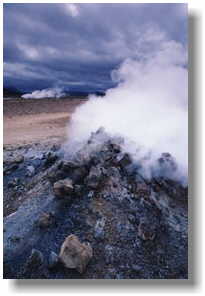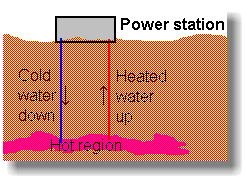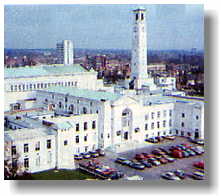![]()
![]()
![]()
![]()
![]()
![]()
![]()
![]()
![]()
![]()
![]()
This site is designed to be viewed on an
800 x 600 screen,
with level 4+ browsers.
Created by Andy Darvill,
Science teacher at
Broadoak Community School,
Weston-super-Mare, England
Web site www.darvill.clara.net
Introduction How it works More details Advantages Disadvantages Is it renewable?
![]()
Introduction
|
The centre of the Earth is around 6000 degrees Celsius - hot enough to melt rock. Even a few kilometres down, the temperature can be over 250 degrees Celsius. In general, the temperature rises one degree Celsius for every 36 metres you go down. In volcanic areas, molten rock can be very close to the surface. Geothermal energy has been used for thousands of years in some countries for cooking and heating. The name "geothermal" comes from two Greek words: "geo" means "Earth" and "thermal" means "heat". |
 |
![]()
![]()
More details
Geothermal
energy is an important resource in volcanically active places such as
Iceland and New Zealand.
How useful it is depends on how hot the water gets. This depends on
how hot the rocks were to start with, and how much water we pump down
to them.
Water is pumped down an "injection well", filters through the cracks in the rocks in the hot region, and comes back up the "recovery well" under pressure. It "flashes" into steam when it reaches the surface.
The steam may be used to drive a turbogenerator, or passed through a heat exchanger to heat water to warm houses. A town in Iceland is heated this way.
The steam must be purified before it is used to drive a turbine, or the turbine blades will get "furred up" like your kettle and be ruined.
See Also:
| Find out more from Mighty River Power, New Zealand |
A geothermal project in Hawaii http://www.geothermalhawaii.com/
A diagram showing a geothermal project http://www.geothermal.marin.org/GEOpresentation/sld037.htm
![]()
Advantages
- Geothermal
energy does not produce any pollution, and does not contribute to
the greenhouse effect.
- The power stations
do not take up much room, so there is not much impact on the environment.
- No fuel is
needed.
- Once you've
built a geothermal power station, the energy is almost free.
It may need a little energy to run a pump, but this can be taken from the energy being generated.
![]()
Disadvantages
- The big problem
is that there are not many places where you can build a geothermal
power station.
You need hot rocks of a suitable type, at a depth where we can drill down to them.
The type of rock above is also important, it must be of a type that we can easily drill through.
- Sometimes a
geothermal site may "run out of steam", perhaps for decades.
- Hazardous gases and minerals may come up from underground, and can be difficult to safely dispose of.
![]()
Is it renewable?
Geothermal
energy is renewable.
The energy
keeps on coming, as long as we don't pump too much cold water down and
cool the rocks too much.
![]()
|
|
|
Want
to discuss alternative energy issues? by James Wilson |

